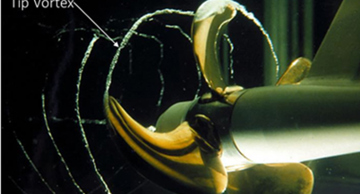Cavitation inception speed – CIS
Many naval vessels have a requirement for cavitation inception speed (CIS). This is the highest speed at which the ship can be operated without any cavitation on the propeller(s), or any appendix or rudder(s) for that matter.
- A ship with a mission that requires low levels of radiated acoustic noise, such as research vessels not wanting to scare off the fish they want to survey or a naval vessel intended for submarine hunting want to be able to operate at as high speed as possible without cavitation. The reason for this is to avoid the significant increase in noise caused by cavitation. There is a step change in the noise level between non-cavitating propeller noise and noise from a cavitating propeller. This step change happens quickly, so even a small amount of cavitation gives rise to significant increase in noise.
- To find the cavitation inception speed a special cavitation test, dedicated to find incipient cavitation only, is carried out. By varying different operational parameters inception of various types of cavitation can be mapped. In contrast, the purpose of a standard cavitation test is to study fully developed cavitation – to see if it is erosive and to measure how much noise it generates. In an inception test one starts with a propeller completely free from the cavitation type in question. Then operational parameters are varied until that particular cavitation starts. At this point the cavitation is barely visible – it is the very inception point that is sought after. When all points are combined to form limit curves for the different cavitation types; suction side sheet cavitation, root cavitation, tip vortex, hub vortex, etc another curve representing the operation of the vessel is overlaid in the diagram. The intersection between this curve and propeller cavitation curves yields the inception speeds.
- The diagram is an example of a cavitation inception diagram with only two types of cavitation shown. The practical procedure to create such a diagram involves setting the cavitation tunnel to a certain cavitation number(s) that can be described as a measure of cavitation sensibility. The lower the cavitation number the higher the sensibility for cavitation. The cavitation number is set by changing the pressure in the cavitation tunnel. The water velocity in the tunnel is normally kept constant. For each cavitation number the advance ratio (J) that is a measure of the propeller blade angle of attack is varied. If one starts at a low propeller shaft speed (high J) there is no cavitating tip vortex on the suction side. When the propeller shaft speed is gradually increased the point where the tip vortex cavitation just starts will be found. Going from high shaft speed to low one will find the start of the cavitating tip vortex on the pressure side of the blade. In a complete cavitation inception test this process is repeated for all types of cavitation. When all points are found the pressure is changed and the process repeated for the next cavitation number. A complete test takes 1-2 days to carry out.
- For the vast majority of propellers it is the tip vortex cavitation that occurs first. In the diagram it is the first intersection between the ship curve and one of the propeller curves if one follows the ship curve from high cavitation numbers downwards. In the example the first inception is for the tip vortex cavitation on the suction side of the blade at 17.8 knots. The highest achievable cavitation free speed of a vessel varies from 8-10 knots up to 17-19 knots for ships with focus on operation at high speed without cavitation and hence low levels of radiated hydro acoustic noise.
- The most important parameters for high inception speed is the hull design, the position of the propeller in relation to the hull – big clearances to shaft brackets and the hull is good, and the specific load of the propeller. If these prerequisites are met, a high inception speed can be reached with a propeller blade design having an optimum balance between the suction and pressure side cavitation. In the example diagram the highest inception speed would be reached if the ship curve ran through the intersection between the red and the blue curve – then the inception of cavitation is delayed to as high ship speed as possible and the cavitation starts at the suction side and the pressure side simultaneously.

